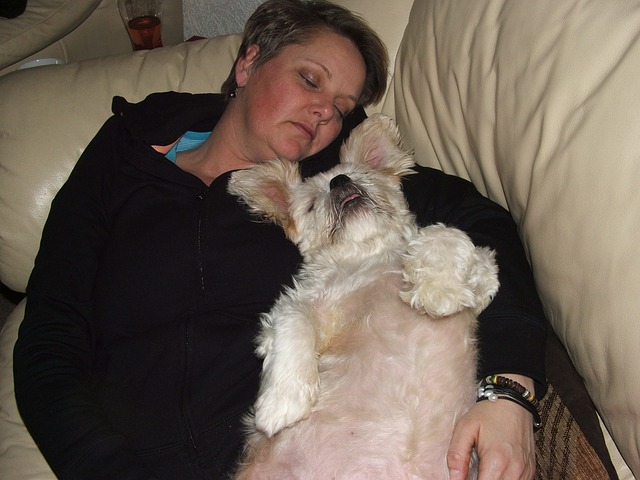Whether you just have a small cold, you’re down for the count with the flu, or you’ve been diagnosed with a serious illness, your dog always seems to know and gives you extra love and affection. But how do they know that you’re sick and need the extra comfort? Is it your behavior that clues them in, or something else entirely?
There are actually several different ways that dogs can sense when we’re sick. Some of those ways have led to specialized service dogs that significantly improve the lives of people with chronic illnesses (whether physical or emotional). Some of those methods are paving the way for new technology to help detect cancer faster and more accurately than current technology. Sit back and enjoy the ride – dogs’ abilities to sense human illnesses are astounding!

They can recognize our facial expressions
Research has shown that dogs can recognize our facial expressions. They can tell just by looking at us whether we’re happy, sad, or angry, so the strain of feeling ill surely shows on our face. Not sure this is true? Try this experiment recommended by VCA Hospitals:
“Try an experiment of your own. Sit facing your dog and break out a huge smile. Your dog will probably relax his ears and wag his tail. Next make a frown and furrow your brow. Your dog will likely respond to this stern look by backing up a bit and looking guilty. Your dog, like generations of dogs before her, has developed the ability to recognize and respond to changes in your facial expressions.”
If you find yourself frowning more than usual because you don’t feel well, your dog is likely to respond by trying to make you feel better in whatever they know how.

They notice changes in our behavior
Dogs thrive on routine, so the tiniest change in your routine or behavior will be noticeable to them. Whether you’re just moving more slowly than usual or you’re spending all day lying on the sofa, your dog knows something is wrong to make you act differently. Again, they want to make you feel better and will do what they can to cheer you up.
This is particularly effective in service dogs that assist people with psychiatric conditions. According to Animal Planet:
“In the case of people with psychiatric conditions like post-traumatic stress disorder (PTSD) or anxiety disorders, dogs can learn to tell when their human companion is feeling anxious or paranoid through body language and changes in behavior. Dogs provide stability and emotional support; they also remind their handlers when to take medication. Service dogs for autistic people not only help them deal with processing auditory and visual stimuli, but they also alert them to behaviors they might not realize they’re engaging in, such as self-harm or self-stimulation.”

They use their sense of smell in amazing ways
This is where it gets really interesting. Dogs’ sense of smell is up to a million times stronger than ours, and they can smell things we can’t even fully understand. They can use their sense of smell to tell when we’re in a bad mood, about to have a seizure, or have cancer. Here’s a rundown of some of the ways dogs use their amazing sense of smell to tell when we aren’t feeling well.
They can smell the rise and drop of our feel-good hormones
Oxytocin, dopamine, and serotonin are chemicals in the brain that are all related to mental health. Whether you’re physically or emotionally run down, your dog can smell the changes in these chemicals and do what they can to try to improve your mental health, often by curling up next to you. According to Wisconsin Pet Care:
“Offering comfort and physical closeness many times will boost these feel-good hormones, and your dog is probably sensing that his or her presence increases your happiness, and ultimately makes you feel better. And after all, happiness is contagious, so your pet, in turn, feels good for boosting your mood. Win, win! This fact cannot be ignored when debating whether or not dogs feel empathy.”
They can detect changes in blood sugar
Service dogs for people with diabetes or hypoglycemia can detect high or low levels of blood sugar and alert their owners before they suffer serious effects, such as fainting. This can make a big difference in the quality of people’s lives.
They can assist people with narcolepsy
People with narcolepsy have sleeping problems that can cause them to fall asleep without a moment’s notice. Trained dogs can smell a change in the person before they fall asleep and either alert the person to get to a safe place, sit on their lap to prevent them from falling out of a chair, or stand over their body while they’re on the ground to keep them safe. Scientists aren’t quite sure what specifically it is that the dogs can smell. There are a whole variety of Volatile Organic Compounds (VOCs) that dogs can sense, some of which we haven’t even figured out yet.
Mary McNeight, CPDT-KA, CCS, BGS, Service Dog Academy director of training and behavior, told Sleep Review:
“It’s a biochemical change in the body. We do not know what the particular odor smells like due to the difference between human scent perception and dog scent perception.”
She added that trained dogs can give their owners up to 5 minutes warning before a cataplexy (falling asleep) attack.

They can alert an owner to impending migraines
Studies show that some dogs can alert their owners about an impending migraine up to 2 hours ahead of time, giving them enough time to take a migraine-preventative medication to avoid or lessen the migraine to something that they can function with rather than becoming debilitated.
They can detect cancer
Many studies have shown that dogs are capable of detecting cancer based on sweat, urine, or breath samples with sometimes remarkable accuracy. A 2006 study trained 5 dogs to detect bladder and breast cancer based on breath samples of 55 lung and 31 breast cancer patients and 83 healthy controls. Once they were trained, they correctly detected breast cancer 88% of the time and lung cancer with a 97% accuracy. Regarding a separate but similar study, Nancy Dreschel, a veterinarian in Dairy and Animal Science at Penn State University, told Penn State News:
“A scientist was training dogs to detect bladder cancer in humans by smelling their urine. She said a dog alerted them to a sample from a supposedly healthy person who was being used as a control. On reexamination, that person was found to have bladder cancer, so the dog caught it before anyone else did.”

In another famous case, according to a 1989 article the British Journal, Lancet:
“…A female Half-Border Collie was indeed a woman’s best friend. Her dog kept sniffing at a mole on her thigh but ignored other moles. In fact, the dog had actually tried to bite off the mole when she was wearing shorts. The woman consulted her doctor, the mole was excised and the diagnosis confirmed a malignant melanoma.”
Scientists are currently trying to identify which VOCs dogs are smelling when they identify cancer in the hopes of developing machines that will be able to test those same compounds, meaning dogs are helping to invent new technology to help improve our health.
Usually, when your dog’s behavior changes, it means that it’s time for a trip to the vet. Maybe, though, your dog is trying to send YOU to the doctor instead!
(H/T: Wisconsin Pet Care, Mother Nature Network, Animal Planet, VCA Hospitals)
